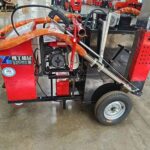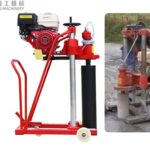Asphalt crack filling equipment refers to a range of machinery designed to repair cracks in asphalt surfaces by sealing them. These machines ensure that cracks are filled efficiently, preventing water, debris, and chemicals from penetrating the pavement structure and causing larger issues like potholes or base failure. Modern equipment varies in size, functionality, and application methods, catering to diverse needs from small-scale residential repairs to large-scale commercial projects. Asphalt surfaces are the backbone of modern infrastructure, from highways and parking lots to airport runways and residential driveways. However, these surfaces are constantly exposed to harsh weather conditions, heavy traffic, and natural wear and tear, leading to cracks that compromise safety and durability. Addressing these cracks promptly is critical to preventing further deterioration, and this is where asphalt crack filling equipment plays a pivotal role.
Applications of Asphalt Crack Filling Equipment
- Municipal Road Maintenance: Cities and towns use large-scale equipment to repair highways, streets, and bridges.
- Commercial Parking Lots: Retail centers, offices, and hotels maintain customer-friendly surfaces.
- Airports: Runway cracks are critical safety issues addressed by high-speed, precision equipment.
- Industrial Facilities: Warehouses and factories seal cracks to protect heavy machinery and inventory.
Key Components and Features
When choosing asphalt crack filling equipment, it is important to understand the key features and components that contribute to performance and durability:
Heated Tanks: Essential for melting hot-pour crack fillers. These tanks are usually propane or diesel-fired and equipped with thermostatic temperature controls.
Agitators: Keep the sealant evenly mixed and prevent scorching.
Hoses and Wands: Allow for controlled and precise application of the filler into the crack.
Temperature Controls: Maintain the ideal temperature range for consistent material flow and optimal adhesion.
Pressure Systems: Facilitate the smooth and continuous movement of the sealant from the tank to the application wand.
Benefits of Using Asphalt Crack Filling Equipment
Using the right equipment to fill cracks in asphalt surfaces brings numerous advantages, including:
- Cost Efficiency
Timely crack filling prevents larger problems that require expensive repairs or resurfacing. Equipment-based crack sealing minimizes labor costs and reduces downtime. - Improved Safety
Crack-free pavement reduces tripping hazards and minimizes the risk of accidents for both vehicles and pedestrians. - Extended Pavement Life
Properly filled cracks block water and other elements from penetrating the surface, preserving the pavement’s structural integrity. - Increased Aesthetic Appeal
Sealed cracks enhance the appearance of roads, driveways, and parking lots, giving them a clean and well-maintained look. - Environmental Benefits
By extending the life of the pavement, fewer raw materials are needed for new asphalt production, reducing the carbon footprint associated with road repairs.
Maintenance and Safety Tips
To ensure the longevity and safe use of asphalt crack filling equipment, follow these maintenance and safety guidelines:
Regular Cleaning: Clean the equipment after each use to prevent sealant buildup.
Inspect Components: Check hoses, valves, burners, and tanks for wear and tear.
Follow Manufacturer Guidelines: Adhere to operating procedures and maintenance schedules.
Wear Protective Gear: Always use gloves, safety glasses, and flame-resistant clothing when operating hot-pour machines.
Operate in Ventilated Areas: Ensure good airflow to prevent the accumulation of fumes and gases.



